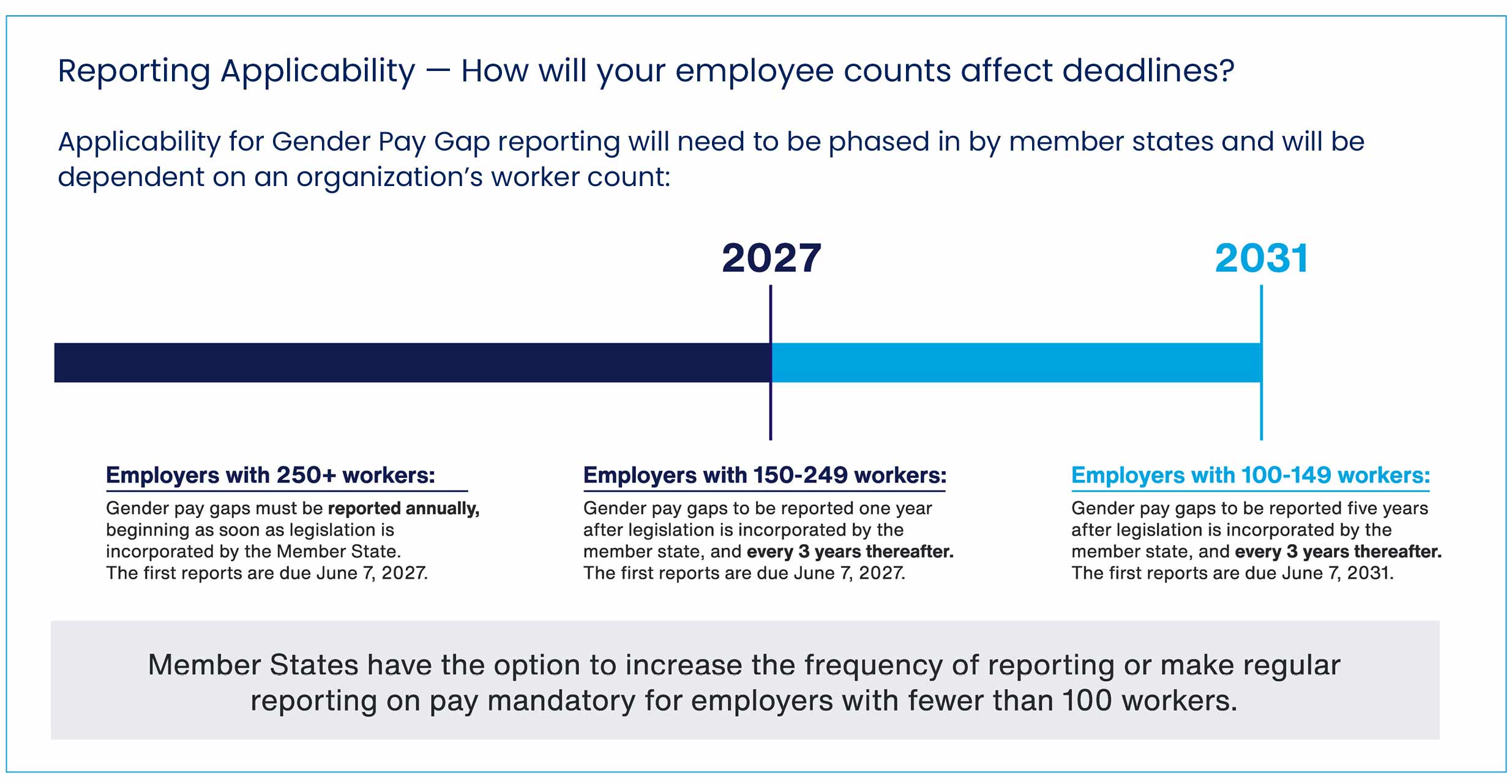- Timeline may be faster than you think. While EU member states have until June 2026 to adopt the EU directive’s requirements, early adopters are expected. U.S. organizations with a heavy European presence could have to comply as early as 2025.
- Develop a global pay equity strategy. Leading employers are moving to embed a cohesive fair pay strategy in their compensation philosophy and apply it consistently throughout their global employee base.
- Don’t get lost in the shuffle. While the immediacy of compensation tasks such as salary budget planning take precedent, employers should resist leaving their global pay equity compliance and strategy efforts on the backburner.
This article is Part 2 of a two-part series that examines requirements for the European Union’s Pay Transparency Directive. Part 1 focused on specifics of the law and what it means for EU employers. Part 2 focuses on how U.S.-based employers with operations in the EU may go about developing a global pay equity strategy and reporting plan.
While the European Union’s recently passed Pay Transparency Directive is top of mind for employers based in EU member states, it might feel distant to United States-based organizations. Thus, the inclination for many American organizations could be to keep it on the back burner and prepare to comply when the time comes.
Based on the directive’s requirements and ramifications, this approach would likely be shortsighted and potentially costly.
Tool: Pay Equity Laws by State — Are You in Compliance?
Multinational organizations with operations in Europe, or those with aspirations to expand to the EU in the near future, need to start preparing. As detailed in Part 1 of this series, EU members have until June 2026 to adopt the requirements, with immediate compliance stipulated for employers with 250 or more workers.
It’s unclear when individual EU countries will begin implementing the legislation, but insiders expect early adopters — those with strict reporting requirements already in place — to move forward in 2025.
Thus, the onus is on U.S.-based companies that operate in any of these jurisdictions to examine whether their global pay equity strategy and operations account for this seismic shift.
Action Items for Multinational Employers
Larger U.S. organizations increasingly need to track and comply with a growing web of pay transparency and salary history ban laws, and enforcement is ramping up. Some state-level jurisdictions — namely, California and Illinois — have pay data reporting laws that approach the stringency of the EU directive; however, these state-level requirements are nascent and distinct from the EU directive.
Therefore, employers with operations in EU member states will need to start laying the groundwork for the expansive reporting requirements. While the directive’s core requirements will be absorbed by each member state, enactment timelines and reporting deadlines will certainly differ.
What’s more, the directive details minimum requirements — meaning individual countries can decide whether or not to expand on those. It may be possible to see compliance timelines based on employer size, as indicated in the figure below. Smaller EU nations — those with populations of 10 million or less — are prime candidates to expand the directive’s various requirements to organizations with fewer than 100 workers.

Initial steps employers likely need to take include:
- Determine applicability. For organizations operating across multiple jurisdictions, identify all operating units with more than 100 workers.
- Review worker categories. Explore different ways of grouping employees or review existing methods. Carry out a pay gap analysis to determine pay gaps within worker categories.
- Conduct a pay equity analysis. Where gaps exceed 5%, carry out a detailed analysis to establish objective justification for the difference. Where there is no objective justification for pay disparities, implement steps to remove those gaps at the earliest opportunity.
- Update compensation policies. Update pay policies to meet all requirements and ensure accessibility; also, review labor contracts for pay secrecy clauses.
- Review hiring processes. Mitigate the potential for unconscious bias by providing clear criteria for HR teams. Ensure vacancy notices and job titles are not affiliated with gender. Implement a salary history ban at all stages of recruitment.
- Set employee representatives up for success. Prepare to enact systems for employee representatives, if such procedures are not already in place. Training on the directive’s requirements may benefit employee representatives. Employers should consider in-house training to build trust.
Additional strategy implementation measures may include benchmarking to evaluate salary ranges, and generating clear and detailed career advancement policies.
Update or Implement Your Global Pay Equity Strategy
The general goal of pay transparency and pay data reporting legislation is to move organizations toward pay and workplace equity. This can be an arduous and ongoing process, so basic compliance may well be the initial goal for many employers.
Read: Researching the Expanding World of Pay Transparency
Some employers, though, are pushing toward creating truly equitable companies that embed a cohesive fair pay strategy in their compensation philosophy and apply it consistently throughout their global employee base.
Therefore, the EU directive may help organizations enhance an existing global pay equity strategy or spearhead an initial one.
Organizations developing a strategy may consider components such as:
- A centralized approach. This may drive greater efficiency than reliance on local management.
- Strategic pay transparency. Determine whether it is more appropriate to meet compliance mandates at the individual jurisdiction level or create a standard framework built to address across-the-board requirements. In doing so, organizations should determine what pay information can be shared and who can access it.
- Timelines and communication. Organizations generally find creating and implementing a global pay equity strategy from scratch is complex and time-intensive. A realistic timeline is two years, and it likely will need regular refinement. Continuous consultation with HR business partners and identification of key stakeholders are among the common tasks. It may also be prudent to work with an outside partner that can maintain attorney-client privilege during the process.
As summer 2024 approaches, salary budget planning season and other key compensation priorities will come to the forefront. While their immediacy is warranted, employers — particularly those U.S.-based entities with operations in the EU — should refrain from shirking their global pay equity compliance and strategy efforts or leaving them on the backburner.
EU directive compliance is dependent on preparation ... and action.
Editor’s Note: Additional Content
For more information and resources related to this article, see the pages below, which offer quick access to all WorldatWork content on these topics:







